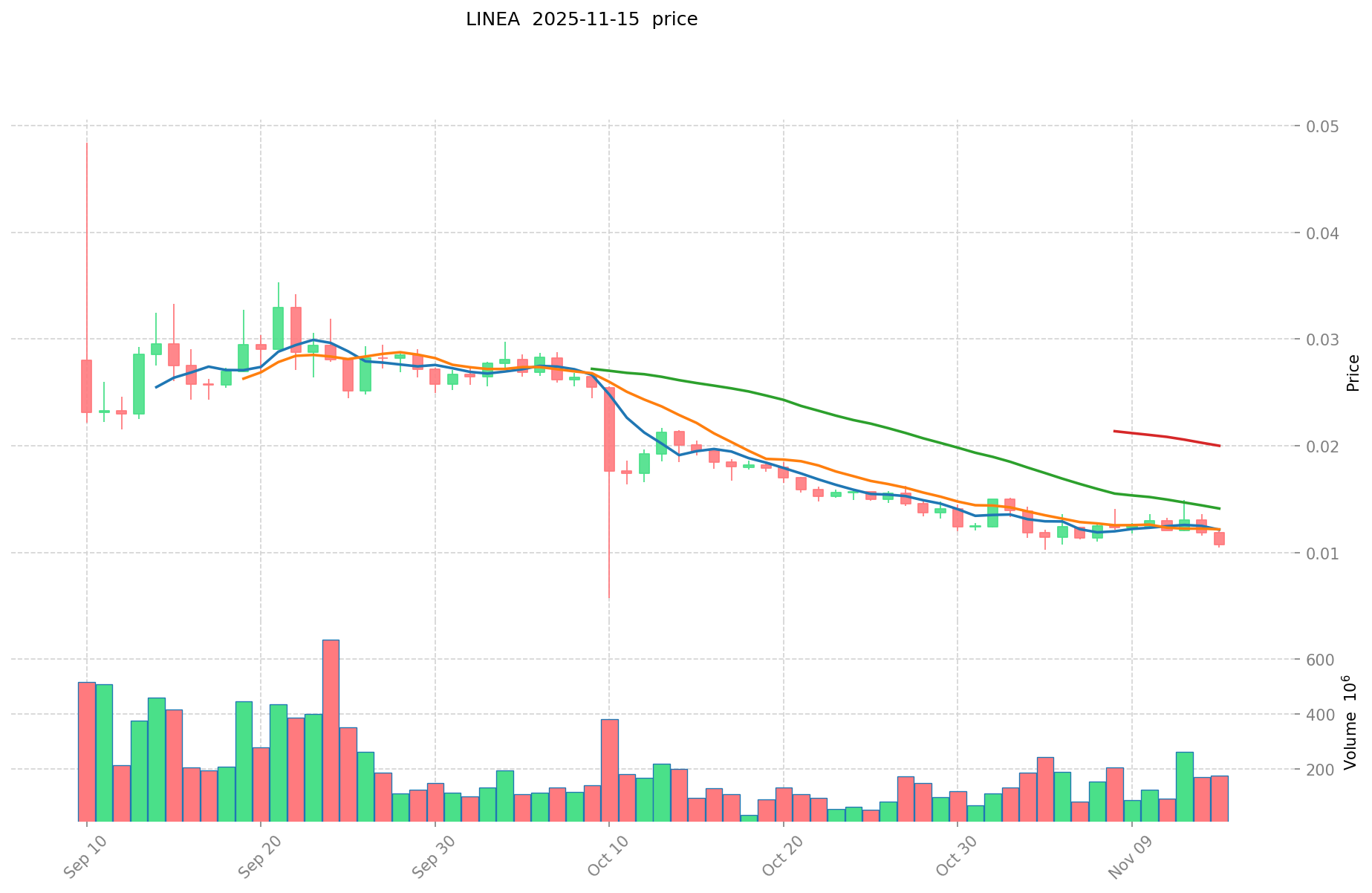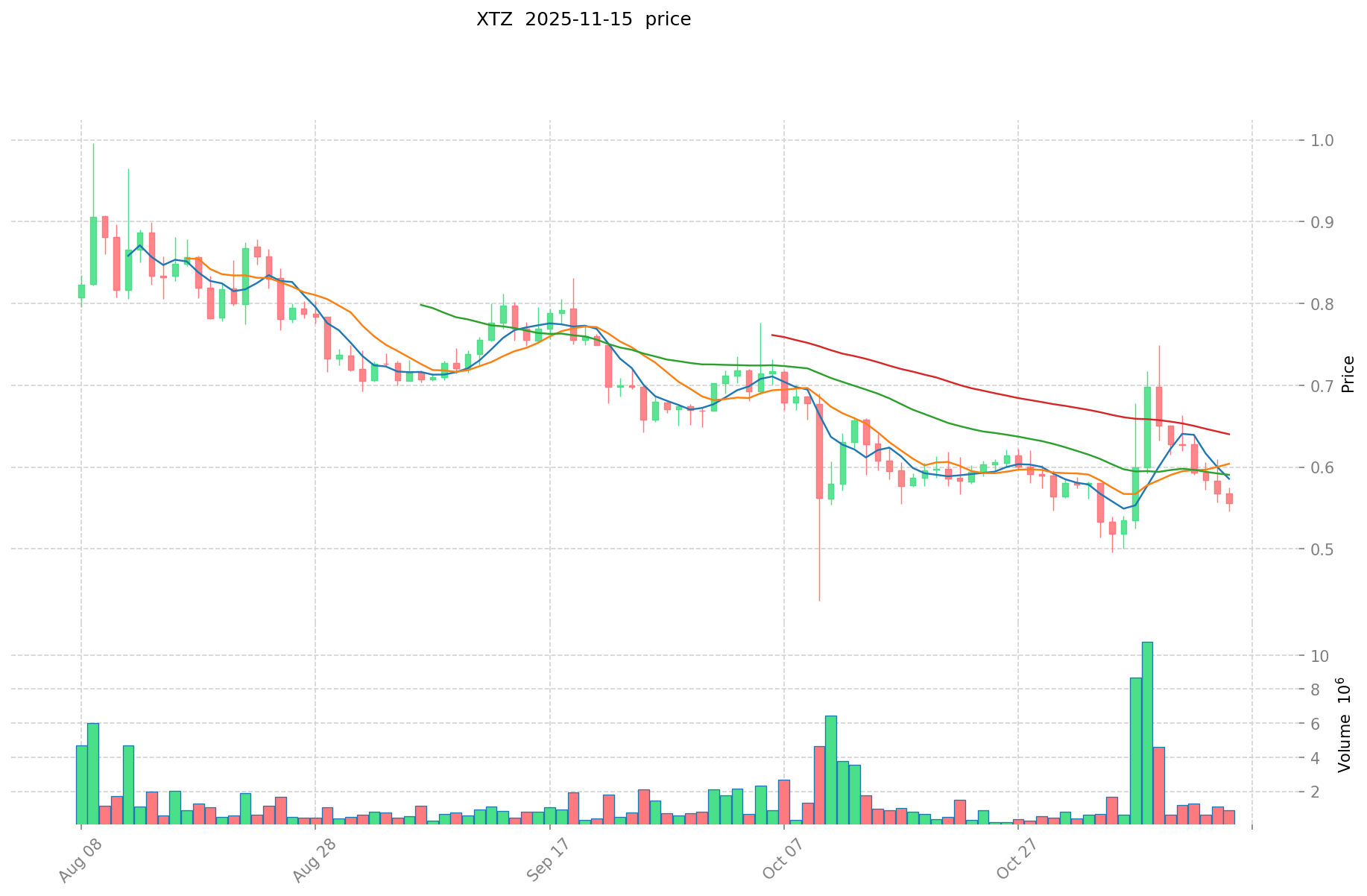LINEA vs XTZ: Comparing Scalability Solutions for Ethereum and Tezos Blockchains
Introduction: LINEA vs XTZ Investment Comparison
In the cryptocurrency market, the comparison between LINEA and XTZ has been an unavoidable topic for investors. The two not only show significant differences in market cap ranking, application scenarios, and price performance, but also represent different positions in the crypto asset landscape.
Linea (LINEA): Launched in 2025, it has gained market recognition for its role as a next-generation Ethereum Layer 2 scaling solution.
Tezos (XTZ): Since its inception in 2017, it has been hailed as a self-amending cryptographic ledger, representing one of the more established blockchain platforms.
This article will provide a comprehensive analysis of the investment value comparison between LINEA and XTZ, focusing on historical price trends, supply mechanisms, institutional adoption, technological ecosystems, and future predictions, while attempting to answer the question most crucial to investors:
"Which is the better buy right now?"
I. Price History Comparison and Current Market Status
LINEA (Coin A) and XTZ (Coin B) Historical Price Trends
- 2025: LINEA reached its all-time high of $0.0484 on September 10, 2025, but subsequently experienced a significant decline.
- 2021: XTZ hit its all-time high of $9.12 on October 4, 2021, marking a major milestone for the project.
- Comparative analysis: In recent market cycles, LINEA dropped from its high of $0.0484 to a low of $0.00575, while XTZ has fallen from its peak of $9.12 to current levels, showing a more prolonged bearish trend.
Current Market Situation (2025-11-16)
- LINEA current price: $0.01073
- XTZ current price: $0.5721
- 24-hour trading volume: LINEA $860,754.66 vs XTZ $258,979.40
- Market Sentiment Index (Fear & Greed Index): 10 (Extreme Fear)
Click to view real-time prices:
- View LINEA current price Market Price
- View XTZ current price Market Price


II. Key Factors Influencing Investment Value of LINEA vs XTZ
Supply Mechanisms Comparison (Tokenomics)
- LINEA: No native token currently available as Linea is an Ethereum Layer 2 scaling solution
- XTZ (Tezos): Inflationary model with dynamic issuance through baking (staking) rewards
- 📌 Historical Pattern: Tezos' supply mechanism allows for steady inflation which supports network security, while Linea currently operates without its own token economy.
Institutional Adoption and Market Applications
- Institutional Holdings: Tezos has attracted some institutional interest, particularly from companies interested in its governance model
- Enterprise Adoption: Tezos has applications in enterprise solutions like tokenized assets and digital securities, while Linea is positioned as a developer-friendly scaling solution for Ethereum applications
- Regulatory Attitudes: Both projects face varying regulatory treatment across jurisdictions, with Tezos generally having more established regulatory relationships due to its longer market presence
Technical Development and Ecosystem Building
- LINEA Technical Development: Built as an EVM-compatible ZK-rollup Layer 2 solution focused on scaling Ethereum while maintaining security
- XTZ Technical Development: Employs a self-amending blockchain protocol that allows for seamless upgrades without hard forks through on-chain governance
- Ecosystem Comparison: Linea leverages Ethereum's ecosystem while focusing on developer tools and infrastructure; Tezos has built its own ecosystem with emphasis on NFTs, digital art platforms, and financial applications
Macroeconomic Factors and Market Cycles
- Performance in Inflationary Environments: Tezos offers staking rewards which can partially offset inflation effects for holders
- Macroeconomic Monetary Policy: Both are affected by broader crypto market trends which correlate with monetary policies
- Geopolitical Factors: Tezos has established global partnerships and adoption across multiple regions, while Linea's impact is tied to Ethereum's global presence and adoption
III. 2025-2030 Price Prediction: LINEA vs XTZ
Short-term Prediction (2025)
- LINEA: Conservative $0.0100862 - $0.01073 | Optimistic $0.01073 - $0.0122322
- XTZ: Conservative $0.51525 - $0.5725 | Optimistic $0.5725 - $0.65265
Mid-term Prediction (2027)
- LINEA may enter a growth phase, with estimated prices $0.00937087382 - $0.01557755648
- XTZ may enter a growth phase, with estimated prices $0.48469996875 - $0.9435492725
- Key drivers: Institutional capital inflow, ETF, ecosystem development
Long-term Prediction (2030)
- LINEA: Base scenario $0.016480294132965 - $0.019117141194239 | Optimistic scenario $0.019117141194239+
- XTZ: Base scenario $0.89999477957475 - $1.286992534791892 | Optimistic scenario $1.286992534791892+
Disclaimer: This analysis is based on historical data and market projections. Cryptocurrency markets are highly volatile and unpredictable. This information should not be considered as financial advice. Always conduct your own research before making investment decisions.
LINEA:
| 年份 | 预测最高价 | 预测平均价格 | 预测最低价 | 涨跌幅 |
|---|---|---|---|---|
| 2025 | 0.0122322 | 0.01073 | 0.0100862 | 0 |
| 2026 | 0.012858832 | 0.0114811 | 0.008496014 | 7 |
| 2027 | 0.01557755648 | 0.012169966 | 0.00937087382 | 13 |
| 2028 | 0.0167872511004 | 0.01387376124 | 0.0086017319688 | 29 |
| 2029 | 0.01763008209573 | 0.0153305061702 | 0.011191269504246 | 42 |
| 2030 | 0.019117141194239 | 0.016480294132965 | 0.012525023541053 | 53 |
XTZ:
| 年份 | 预测最高价 | 预测平均价格 | 预测最低价 | 涨跌幅 |
|---|---|---|---|---|
| 2025 | 0.65265 | 0.5725 | 0.51525 | 0 |
| 2026 | 0.67995825 | 0.612575 | 0.3307905 | 7 |
| 2027 | 0.9435492725 | 0.646266625 | 0.48469996875 | 12 |
| 2028 | 0.969787697475 | 0.79490794875 | 0.4848938487375 | 38 |
| 2029 | 0.917641736037 | 0.8823478231125 | 0.776466084339 | 54 |
| 2030 | 1.286992534791892 | 0.89999477957475 | 0.656996189089567 | 57 |
IV. Investment Strategy Comparison: LINEA vs XTZ
Long-term vs Short-term Investment Strategy
- LINEA: Suitable for investors focused on Ethereum scaling solutions and Layer 2 ecosystem growth
- XTZ: Suitable for investors seeking established blockchain platforms with governance features
Risk Management and Asset Allocation
- Conservative investors: LINEA: 30% vs XTZ: 70%
- Aggressive investors: LINEA: 60% vs XTZ: 40%
- Hedging tools: Stablecoin allocation, options, cross-currency portfolios
V. Potential Risk Comparison
Market Risks
- LINEA: High volatility due to early-stage development and dependency on Ethereum ecosystem
- XTZ: Prolonged bearish trend and competition from newer blockchain platforms
Technical Risks
- LINEA: Scalability challenges, network stability issues as an L2 solution
- XTZ: Potential security vulnerabilities, governance model risks
Regulatory Risks
- Global regulatory policies may impact both differently, with XTZ potentially facing more scrutiny due to its longer market presence
VI. Conclusion: Which Is the Better Buy?
📌 Investment Value Summary:
- LINEA advantages: Ethereum Layer 2 scaling solution, potential for growth in the expanding Ethereum ecosystem
- XTZ advantages: Established platform, self-amending protocol, proven governance model
✅ Investment Advice:
- New investors: Consider a balanced approach, leaning towards XTZ for its established history
- Experienced investors: Explore LINEA for its growth potential in the Ethereum ecosystem
- Institutional investors: Evaluate both, with XTZ for its governance features and LINEA for its technical innovation
⚠️ Risk Warning: The cryptocurrency market is highly volatile. This article does not constitute investment advice. None
VII. FAQ
Q1: What are the main differences between LINEA and XTZ? A: LINEA is an Ethereum Layer 2 scaling solution without its own native token, while XTZ (Tezos) is an established blockchain platform with a self-amending protocol and native cryptocurrency. LINEA focuses on Ethereum ecosystem scalability, whereas XTZ offers a standalone blockchain with governance features.
Q2: Which has shown better price performance historically? A: XTZ (Tezos) has a longer price history, reaching an all-time high of $9.12 in October 2021. LINEA, being newer, reached its all-time high of $0.0484 in September 2025. However, both have experienced significant declines from their peaks.
Q3: How do their supply mechanisms differ? A: LINEA currently has no native token, as it's an Ethereum Layer 2 solution. XTZ uses an inflationary model with dynamic issuance through baking (staking) rewards, which supports network security.
Q4: What are the key factors influencing their investment value? A: Key factors include institutional adoption, technical development, ecosystem building, and macroeconomic factors. XTZ has more established institutional relationships and a diverse ecosystem, while LINEA's value is tied to Ethereum's growth and scalability needs.
Q5: How do their long-term price predictions compare? A: By 2030, LINEA's base scenario predicts a range of $0.016480294132965 - $0.019117141194239, while XTZ's base scenario predicts $0.89999477957475 - $1.286992534791892. Both have potential for higher prices in optimistic scenarios.
Q6: Which is considered a better investment for different types of investors? A: New investors might prefer XTZ for its established history. Experienced investors could explore LINEA for its growth potential in the Ethereum ecosystem. Institutional investors may consider both, evaluating XTZ for governance features and LINEA for technical innovation.
Q7: What are the main risks associated with investing in LINEA and XTZ? A: LINEA faces high volatility and technical risks as an early-stage Layer 2 solution. XTZ risks include prolonged bearish trends, competition from newer platforms, and potential governance model issues. Both face regulatory risks, with XTZ potentially under more scrutiny due to its longer market presence.
Share
Content